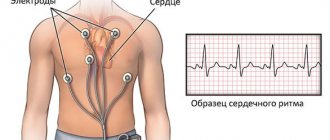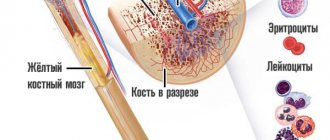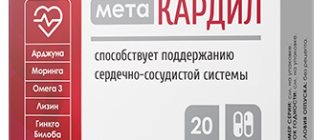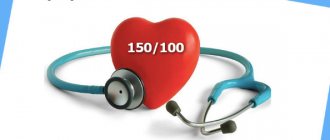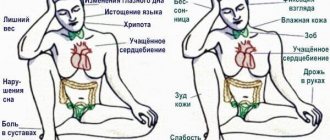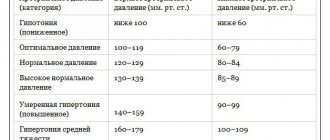In medical practice, there are two types of blood pressure: systolic or upper and diastolic - lower.
The first shows the force with which blood is ejected from the cardiac structures. The second is the force of the blood’s influence on the vessels at the moment of muscle relaxation.
If the lower pressure is increased to 100, this is a direct indication of pathology. Of course, the days of the outdated 120 to 80 ratio are long gone. The paradigm has changed.
Now, when calculating blood pressure levels, the individual norm is taken into account. The upper limit of the diastolic indicator is limited to 90 mmHg. Anything more is pathology. Therefore, there is no need to talk about the norm here.
In what cases does an increase in the lower arterial indicator occur, how to correctly determine the main factor, and what to do in such a situation? These questions must be answered.
The main reasons for the increase in diastolic pressure
The factors behind the development of hypertension with an increase in lower blood pressure levels are diverse. The reason does not always lie in the heart and blood vessels.
Cardiac pathologies account for up to 20% of all factors in the development of diastolic hypertension.
What are the reasons:
Myocardial ischemia
The reason for the increase in lower pressure to 100 mm Hg. Art. may consist of congestive heart failure, coronary artery stenosis, coronary artery disease (abbreviated as ischemic heart disease), pathologies such as a heart attack in the period after a previous condition.
You need to understand it carefully; only a cardiologist can cope with the task.
The main cause of hypertension is a violation of general hemodynamics and cardiac output. Correction is carried out using medicinal and surgical methods.
Vascular atherosclerosis
Especially the big ones. Including the main artery of the human body - the aorta. During the process, a narrowing or blockage (more often) of the lumen of a hollow organ with a cholesterol plaque is observed.
Over time, the lipid structure calcifies and becomes practically impervious to special drugs. Blood flow is disrupted due to narrowing of the artery lumen.
The heart has to work harder to supply the organs with blood, which leads to increased blood pressure. In a situation where the disease is advanced, surgical intervention cannot be avoided.
There are risks here: old age does not allow the patient to be fully operated on.
Pinching of the arteries supplying the brain
Diseases associated with ischemia of cerebral structures as a result of pathologies of the musculoskeletal system and vascular structures.
A lower pressure of 100 means that vertebrobasilar syndrome and osteochondrosis of the cervical spine are possible. Fibrosis of the neck muscles also affects, and tumors of the vertebral structures are possible (less commonly).
As a result, the brain, and especially the centers responsible for regulating vascular tone, do not receive enough oxygen and nutrients. The brain gives chaotic signals, hence possible surges in blood pressure and an increased risk of stroke or heart attack.
Hormonal diseases
Diabetes, hyperthyroidism, hypercortisolism and some others. All of them are associated with excessive production of special active substances in the body: cortisol, T3, T4, TSH, norepinephrine, adrenaline, catecholamines.
In these cases, hypertension is far from the only pathology that occurs. With an increase in dopamine, organic psychoses are possible, up to the development of schizophreniform states, TSH - growth of the thyroid gland like a diffuse or nodular goiter, etc.
Correction of the condition in the interests of the patient himself. Because otherwise the whole body will suffer.
Kidney diseases
Diverse in character. They are similar in one way: renin synthesis is disrupted and the filtering function changes. Hence, possible disorders of blood pressure regulation, up to malignant hypertension.
This condition is extremely difficult to correct even in a hospital setting. There is no need to push it to the limit. It is better to contact a medical facility when the first alarming symptoms appear.
Condition after stroke
A lower pressure of 100 may indicate a pathological process in the brain. Typically, increased diastolic pressure occurs in the period following a stroke.
This needs to be dealt with, but blood pressure levels do not drop overnight. It takes some time.
What to do if your blood pressure is 110/100
IT IS IMPORTANT TO KNOW!
STILL STRUGGLE WITH ARTERIAL HYPERTENSION INCORRECTLY? Reduces stress hormone levels and prevents oxygen starvation Read more »
If diastolic pressure reaches 100 mm Hg. Art., and the person’s condition immediately worsens, he feels dizzy and has a headache, and cold sweat appears, then you need to act immediately. There is no need to take medications right away, since the systolic pressure will decrease, which will only complicate the patient’s condition. Initially, you will need to take the following first aid measures:
- Try to control your emotions and calm down.
- You need to take a comfortable position; for this it is recommended to sit down and put a pillow under your lower back. You can also lie down, but your head should be elevated.
- Open all the windows in the room to let fresh air in.
- The patient needs to drip valerian or Corvalol in a volume of 30 drops and give it to drink. This allows you to calm down.
- If pain appears in the heart area, then you need to put nitroglycerin under your tongue and dissolve the tablet.
- A 15-minute cold compress on the neck will help, after which you need to do a massage in order to normalize blood circulation.
- To improve the condition, take a warm bath for your feet and soak them for 5-10 minutes.
In addition to the measures described, treatment will be required. It should be prescribed only by doctors, only after diagnosis and determination of the causes.
Treatment
It is generally accepted that to reduce blood pressure it is necessary to take medications. For this, diuretics are often used, also known as diuretic tablets, but they can also be replaced with traditional medicine. For this we use:
- Infusions and decoctions made from horsetail.
- Bearberry decoction.
- Products based on lingonberries.
If the use of herbal components fails, blood pressure can be normalized with diuretics, which include the following drugs:
- Diacarb.
- Furosemide.
- Hypothiazide.
Such medications can only be used after consultation with a doctor, since diuretics will remove not only fluid, but also potassium and magnesium, which are very important for the functioning of the cardiovascular system. Due to this, it is better to use diuretics with potassium medications: Asporcam, Panangin.
If the pressure of 110 to 100 appears from time to time and is unstable, in this case it is recommended to use antihypertensive tablets, which will have a general effect. Doctors recommend using:
- Methyldopa.
- Moxonidine.
- Albarel.
Therapy using these tablets makes it possible to normalize the functioning of the nervous system, thereby reducing the number of signals that contribute to vasoconstriction. Such medications can reduce both systolic and diastolic blood pressure by eliminating vascular spasms.
To constantly maintain blood pressure within normal limits, doctors often prescribe ACE inhibitors. Possible medications include:
- Ramiril.
- Enalapril.
- Perindopril.
Therapy with ACE inhibitors takes a long time, and in some cases the tablets will need to be taken for the rest of your life. If the pressure is 110/100 mmHg. Art. appears often, doctors also recommend using medications from the group of beta blockers. These include:
- Losartan.
- Valsartan.
- Eprosartan.
The tablets are taken once a day, and for a positive effect from the medication, you need to take a course of at least 1 month. Beta blockers have minimal side effects. If hypertension is diagnosed at stages 2-3, when the pressure is constantly at high limits, then doctors can prescribe several drugs at once, which will affect different organs and systems.
You can lower diastolic pressure using folk remedies. Simple recipes are used for this:
- Motherwort. You need to add 1 tbsp to a glass of boiling water. herbs and leave to brew for 30 minutes. After preparation, the volume is divided into 3 parts and consumed after lunch. Be sure to drink 1/3 before bed.
- Birch buds. This ingredient in the amount of 1 tbsp. pour 200 ml of boiling water and leave to brew. The medicine should be taken 3 times a day before meals, 3 tbsp. l.
Traditional healers recommend massaging your earlobes, quite vigorously, to the point of pain. After a few minutes, the pressure will begin to decrease slightly. In addition to the described methods of treatment for hypertension and to prevent its occurrence, it is necessary to lead a correct lifestyle and use preventive measures.
Physiological (removable) causes
All pathological factors are not limited. The patient may well be the creator of his condition.
Purely physiological, temporary causes of the development of classical and isolated arterial hypertension are also possible.
Long term smoking
Cigarettes contain a lot of toxic substances. Nicotine is a harmless compound in comparison.
In combination, the pathogenic components provoke a persistent increase in blood pressure due to the narrowing of central and peripheral vessels.
Blood flow is disrupted. In chronic smokers, hemodynamics are completely adjusted to the needs of the pathologically altered organism. Persistent hypertension is the “norm” for such patients.
Alcoholism
Drinking alcohol on a regular basis affects the state of the entire cardiovascular system in the same way, but only to an even greater extent.
At the first moment, the pressure really drops, the blood vessels dilate sharply, and the person becomes red.
The next moment the expansion gives way to rapid contraction. Symptoms of hypertension increase like an avalanche.
At a young age, the body can withstand this. But such “training” will sooner or later end in a stroke or heart attack. Which is what happens most often.
Abuse of salt
Sodium chloride salt is necessary for normal life. You can’t completely give up seasoning. But you need to know when to stop. No more than 5-12 grams per day.
Large volumes lead to fluid retention and hemodynamic disturbances.
Too much physical activity
Exhausting yourself in the gym and hoping to become healthier from this is, at a minimum, naive. During mechanical stress, an intense release of corticosteroids and catecholamines occurs.
This is a natural defense mechanism. The person feels neither fatigue nor pain. But can the same be said about the body? Obviously not.
There is a rapid increase in blood pressure, and lower pressure rises faster. Even a trained body is not immune to a jump in blood pressure. It's not worth the risk.
Stress, psycho-emotional overload
Especially nervous shocks. They are quite capable of leading to the development of high blood pressure in the short term.
The duration of such a phenomenon is directly proportional to the duration of the traumatic situation.
Peak hormonal states
Including puberty (puberty), pregnancy, menopause and the menstrual cycle. Therefore, women are more susceptible to increased blood pressure.
The assessment of the factors causing the problem is carried out in a comprehensive manner. Depending on the results of the analysis, we can talk about one way or another of helping the patient.
Causes
If diastolic pressure exceeds 90 points, the doctor can diagnose the occurrence of isolated hypertension. The disease develops under the influence of various factors.
Physiological reasons include the following:
- Kidney pathologies. Impaired functioning of the organ leads to narrowing of the renal arteries. As a result, blood circulation is disrupted and lower pressure increases.
- Oncological formations in the adrenal glands. Such tumors lead to increased synthesis of adrenaline. This hormone causes vasoconstriction.
- Hormonal imbalance. It may be associated with thyroid disease.
If the pressure is 110 to 110, it is quite difficult to determine the reasons. In such a situation, experts often suspect essential hypertension, which occurs as a result of psychosomatic abnormalities. The risk category includes the following patient groups:
- people who experience constant emotional stress;
- persons who lead an insufficiently active lifestyle;
- overweight people;
- people who often face stress.
Sometimes the cause of an increase in lower pressure is physiological processes in the body. This condition can occur during pregnancy or during menstruation. In this case, the indicators are normalized after the end of the condition that provoked the imbalance.
Is this condition dangerous?
Yes, no less dangerous than classic hemodynamic hypertension. Much, however, depends on the type of disease. If both lower and upper pressure are increased at the same time. There are fewer risks.
Isolated forms of pathology are much more dangerous, since pulse pressure (the difference between the upper and lower) varies significantly: a difference of more than 40 mm Hg leads to instability in the functioning of the cardiovascular system.
What specific risks does a diastolic pressure of 100 carry:
- The likelihood of developing an acute cerebrovascular accident as a result of narrowing or rupture of a blood vessel. Actually, a stroke.
- There is a risk of developing cardiac ischemia. The result is myocardial infarction. Develops most often. It shares first place only with stroke. Both of these conditions are deadly.
- Acute heart failure with a high probability of cardiac arrest.
- Hemophthalmos or hemorrhage in the eye.
To prevent pathological consequences, it is necessary to promptly treat arterial hypertension, regardless of its form.
BP 110 over 60
Blood pressure of 110 over 60 also worries patients. They don’t know whether this is the norm or a deviation. Decreased readings are a sign of hypotension, but sometimes this is an individual feature. In adolescents, blood pressure 110 over 60 is normal. The condition does not require drug treatment. The indicators appear due to an incompletely formed nervous and cardiovascular system. Low blood pressure can last a lifetime.
There is no reason to worry if a person at 110 to 60 does not complain of feeling unwell.
Pressure 110 over 50-70 is a sign of a pathological condition. With a periodic decrease in blood pressure to such a level, the patient may complain about a wide variety of clinical symptoms. Patients often mistake them for signs of fatigue. In case of unpleasant symptoms, the blood pressure level is immediately measured.
With hypotension, the patient's body weakens. Over time, chronic fatigue may appear. Blood pressure of 110/60 and hypotension can occur due to the presence of certain medical conditions. At the same time, the indicator is considered normal in older people. Changes in blood pressure are caused by deterioration of the cardiovascular system. The vessels become thin and inelastic. This factor can also provoke the appearance of arterial hypertension.
Fatigue and apathy are common with hypotension
At the early stage of development of hypotension, it is recommended to take a daily walk in the fresh air. Doctors recommend:
- give preference to moderate physical activity;
- start every morning with exercises and a contrast shower;
- eat only balanced and healthy foods;
- get as much rest as possible;
- alternate physical and mental stress.
Patients are prescribed acupressure massage. At the initial stage, hypotension is not dangerous. Blood pressure can be quickly normalized and the risk of complications can be eliminated.
Acupressure will help normalize blood pressure
A blood pressure of 115 over 60 is also normal for a pregnant woman. Decreased rates are due to the weakening of the body, which is actively adapting to its new state. A slightly reduced blood pressure in an expectant mother should not cause concern. You should consult a doctor if you have a pronounced loss of strength.
Symptoms of deviations
Even slightly low blood pressure is accompanied by unpleasant symptoms. They worsen the quality of life. The patient becomes less active. A pressure of 110 over 70 is characterized by the following symptoms:
- headache;
- severe dizziness;
- fainting;
- loss of performance;
- prostration;
- apathy;
- deviation in the functioning of the organs of vision, which is expressed by a feeling of veils before the eyes;
- extraneous sound in the ears;
- lack of coordination;
- drowsiness.
Low blood pressure may cause ringing in the ears
The sick person may lose consciousness at any time. This usually occurs with a sharp decrease in blood pressure. Symptoms intensify when the patient makes movements.
A pressure of 110 over 70 with a pulse of 70 is always accompanied by a disturbance in the functioning of the organs of vision and hearing. The patient complains of a buzzing in the ears. The headache affects the temple area. It is pulsating, appears spontaneously and also disappears suddenly. If there is a sharp decrease in blood pressure, the patient is given first aid to prevent negative consequences.
The patient refuses food. With hypotension, the condition is significantly worsened in the morning. Due to loss of strength, it is difficult for the patient to get out of bed. He has a constant feeling of drowsiness that does not disappear after sleep. At night he may experience insomnia. Patients with hypotension complain of attacks of aggression. They become apathetic. The skin looks unhealthy and turns pale.
Hypotonic people suffer from fatigue and often find it difficult to wake up and force themselves to get up
What is the danger of the condition
A pressure of 115 over 70 is the initial sign of hypotension. The disease is no less dangerous than hypertension. Treatment begins immediately. To confirm the diagnosis, you should visit a medical facility. Before this, you need to understand what exactly could provoke a decrease in blood pressure. Usually this:
- physical exercise;
- stress;
- inactive lifestyle;
- physical and emotional stress, etc.
Tell your doctor the suspected root cause. This information allows you to eliminate the pressure of 110 to 65 as quickly as possible. Normalization of indicators at an early stage can occur without the use of medications.
Stress often leads to a drop in blood pressure
Hypotension is a provocateur of deterioration of blood flow in the internal organs. The brain is the first to suffer. The signs of fatigue that accompany hypotension can become chronic.
There is a risk of injury if you lose consciousness. Fainting is a common sign of hypotension. The cardiovascular system weakens. A blood pressure of 115 over 65 is not dangerous only in the absence of negative symptoms. The very first sign of the disease is general weakness with low blood pressure. Even such a minor symptom cannot be ignored.
What can you do at home?
Actually, nothing. You should urgently call doctors (emergency medical care) and wait for a team led by a paramedic.
Before the doctor arrives, you should take a horizontal position and simply relax as much as your condition allows. No sudden movements or special breathing techniques are needed.
You can take medications only with the permission of the treating specialist and strictly in the prescribed dosage. No more, no less.
A sharp drop in blood pressure will also not lead to anything good (this is how classic antihypertensive medications work), and here a combination of drugs and their dosages is required.
How to reduce lower pressure if it is 100 or more, minimally affecting the upper one:
- take 1/4 Captopril tablet.
- take calcium antagonists (1 tablet of Diltiazem or Verapamil).
Exceeding dosages and taking unspecified medications is strictly prohibited. What this will lead to is unknown.
The described measure is also not a treatment and does not lead to normalization of blood pressure in the long term.
Attention:
Baths, dousing with water, folk remedies, basins with hot water - all these are sabotage techniques. This kind of advice is given by people far from medicine. Self-activity is fraught.
Upon arrival, doctors need to talk about complaints and, if possible, resolve the issue of hospitalization.
If it is impossible to go to the hospital for at least a few days, you should immediately contact a cardiologist to prescribe or adjust therapy.
Treatment methods
If pressure occurs at 110 to 110, what should you do in this situation? First of all, the development of isolated diastolic hypertension is a signal for lifestyle changes. To do this, you should adhere to the following recommendations:
- follow a diet;
- limit consumption of sugary drinks and salt;
- completely eliminate alcoholic beverages and quit smoking;
- actively engage in sports - it is useful to walk a lot, run, skate and roller skate;
- normalize body weight;
- adhere to the principles of proper nutrition;
- avoid stress or extreme tension at work;
- reduce consumption of caffeinated drinks;
- If necessary, consult a psychologist who can help you cope with increased anxiety.
Following these recommendations allows you to cope with isolated hypertension of the first stage. In more complex situations, the help of a doctor is required to select appropriate medications. To normalize the condition, you can take the following groups of remedies:
- beta and alpha adrenergic blockers - these include drugs such as Metoprolol, Terazonin;
- diuretics that remove excess water from the body and reduce the heart rate - this category includes drugs such as Hypothiazide, Xipamide;
- ACE inhibitors, which suppress the synthesis of angiotensin hormones - these include Enalapril, Captopril;
- calcium antagonists, which promote the expansion of vascular walls - this group includes drugs such as Verapamil, Nifedipine;
- tinctures of medicinal plants - usually motherwort and other sedatives are used to treat arterial hypertension.
Dangerous symptoms that require medical attention
Any symptom is considered dangerous. Hypertension is generally unpredictable. Therefore, you need to pay attention to any signals from the body.
Including these:
- Dizziness of a long duration. There may be cerebellar ischemia.
- Complete disorientation in space. The patient can only lie down.
- Intense headache. Usually the pressure is accompanied by squeezing in the occipital region. Variations are possible.
- Nausea and vomiting. Reflexive in nature.
- Fainting. Syncope. Especially of a repeated nature.
- “Disobedience” of arms and legs, half of the body.
- Palpitations or, conversely, a decrease in heart rate to a level less than 60 beats per minute.
- Facial distortions.
- Chest pain of moderate intensity. Pressing, aching character. They radiate to the stomach, shoulder blade and left arm. Discomfort seems to flow through the veins.
- Impaired speech function, hearing, vision, smell, including phantom odors. Neurological focal symptoms characteristic of stroke and other organic brain lesions.
All symptoms require qualified assessment.
As a sign of hypertension
We are talking about infants and preschool children. What blood pressure is considered normal for them? Here the numbers are in the range of 90-100/60-65 mmHg. Art. That is, 110 by 80 mm Hg. Art. for such patients the indicator is increased. First of all, the specialist should think about “white coat” hypertension, that is, an increase in blood pressure as a reaction to the doctor or the environment in medical institutions. If this factor is excluded, the pediatrician analyzes why the baby’s blood pressure may still rise. Possible causes of hypertension in children:
- hereditary predisposition in combination with other provoking factors;
- obesity;
- violation of metabolic processes;
- a large amount of salt in consumed dishes;
- mental or physical stress;
- sedentary lifestyle.
If hypertension is suspected, parents voice the following complaints of the baby or the results of their own observations of him:
What does pressure 100 over 65 mean?
- sleep disturbance;
- dizziness;
- noise in ears;
- nausea;
- headache;
- nosebleeds;
- pain in the heart area.
Diagnostics
In case of newly identified pathology, it is advisable to examine the patient in a hospital setting. If not possible, during outpatient appointments. A cardiologist will help.
If necessary, an endocrinologist, neurologist and nephrologist are involved. Such a “consultation” is not always required, but in most cases.
Accordingly, the list of studies is as follows:
- Assessment of complaints, collection of anamnesis. To objectify symptoms. This is an important step that determines the diagnostic vector.
- Determination of blood pressure levels in both arms.
- Holter monitoring using an automatic programmable tonometer.
- Electrocardiographic study. To assess cardiac function and identify minimal abnormalities. Unfortunately, few people are able to read the result correctly.
- Echocardiography. Ultrasonography.
- Study of hormone levels in the blood.
- Biochemistry of venous blood.
- General analysis of hematological fluid (CFA).
- Study of neurological status, condition of the kidneys and excretory system.
How exactly to examine the patient is decided by specialists.
Therapeutic measures
Treatment is mixed, systematic. It is aimed both at eliminating the root cause of the development of the hypertensive process and at relieving the symptoms that inevitably arise during the course of the disease.
Lowering the lower pressure if it is 100-110 or more must be done carefully, using selective drugs. Rough exposure to classical medications will not work. A complex of medications is needed. Combinations are determined only by a cardiologist.
Since the problem is complex, only an experienced doctor can help. Errors are possible and even probable. But you can’t do anything on your own. It is recommended that all efforts be directed towards finding a competent specialist.
During treatment, and even after therapy, you need to maintain a healthy lifestyle. Don't drink, don't smoke, move more, but within reason, eat right, drink enough fluids, reduce salt intake to an acceptable minimum. These simple recommendations may help save your life.
Prevention
A pressure of 110 over 100 (110) is the basis for contacting a cardiologist. The specialist will recommend following simple rules that will help prevent a sharp deterioration in your health. If you have isolated hypertension, you should definitely adhere to the following:
- reduce salt intake - the daily volume of this product should not exceed 5 g;
- engage in physical therapy – you need to devote at least 3 hours a week to sports activities;
- completely eliminate the use of alcoholic beverages;
- stop smoking;
- maintain normal body weight - for this you need to eat right and increase physical activity;
- consult a psychologist - contacting a specialist is required if anxiety, fear and other psychological abnormalities occur frequently.
An increase in lower pressure should be a reason for an urgent visit to a cardiologist. The specialist will conduct a diagnosis and determine the causes of this condition. To cope with the disorder, it is very important to adjust your lifestyle. In difficult situations, it will not be possible to do without medications. However, only a specialist should select such funds.
Did you like the article? Save it!
Still have questions? Ask them in the comments! Cardiologist Mariam Harutyunyan will answer them.
Ivan Grekhov
Graduated from the Ural State Medical University with a degree in General Medicine. General practitioner

